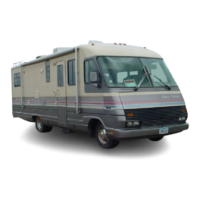When securing a child restraint with a
lap
belt that
has no retractor,
pull the excess webbing through the
adjustment mechanism.
If
the child restraint is still not
secure.
use a different
seating position in the vehicle and/or contact your dealer
and the child restraint manufacturer for help.
Sun Visors
The sun visors
at
the driver's
and
passenger's posi-
tions swing
down
and adjust to provide relief from glare
and bright skies. The visors do not adjust to shade the
side windows.
Swivel tension
may
be adjusted
with
a flat blade
screwdriver
at
the tension adjusting screw.
Front/Side Slider Windows
Tum lock, slide
window
and/ or screen to open
and
close.
REAR VIEW VIDEO MONITOR
If
your motor
l10me
is equipped with the optional
rear
view
video monitor, the wide-angle. fixed-focus camera
is
located
at
the top rear
of
the motor
home.
The rear-
view picture
is
displayed on a
screen
on
the motor home
instrument
panel. The monitor screen
Is
overlayed with
a distance scale reference which gives approximate
distance relationships
of
objects to the rear of the motor
home.
The system operates only while the ignition switch
is
ON,
and
may
be
turned off
at
the
screen
.contral
panel.
Controls on the screen allow you to adjust brightness
and contrast
as
lighting conditions change.
Using the video monitor will take practice. Always
allo'W
more space
for
rna neuvering until you
are
com-
fortable
with using the system. Check the side-mounted
mirrors often
while driving and especially during lane
changes and
when
backing.
up.
CAUTION:
THE
REAR
VIEW
VIDEO
MONIlOR
SYSTEM
PROVIDES
A
GENERAL
VIEW
OF
THE
ROAD
AND
OBJECTSro
THE
REAR
OF
THE
MOTOR
,HOME;VOUR"
PERCEPTION"OF
THIS
VIEW
AND
THE
RElATIONSHIPS
OF
OBJECTS
TO
THE
MOTOR
HOME
AND
EACH
OTHER
WILL
BE
DIFFERENT
THAN
THAT
SEEN
IN
A
REAR
VIEW
.
MIRROR.
UGHT
CONDmONS
AND
THE
ADJUST-
MENT
OF
THE
SCREEN
CONTROLS
WILL
ALSO
AFFECT
YOUR
PERCEPTION.
ALWAYS
USE
THE
SIDE-MOUNTED
REAR
VIEW
MIRRORS
WITH
THE
VIDEO
MONIlORSYSTEM.·
The camera lens is exposed to road dirt and will get
dirty often.
Clean the camera lens
and
monitor screen
with
a quality glass cleaner
and
non-abrasive cloth or
towel.
AUTOMATIC LEVELING SYSTEM .
Controls for the optional leveling system
are
located
on
the cab floor next to the driver's seat.
A detailed operating
and
maintenance
guide
is
included
in
your owner's information
package.
Read
all instruc-
9
tion for this system carefully before operating the
system.
DRIVING
AND
PARKING
Once
you become accustomed to
the
feel
of
the con-
trals
and
the reference points from the driver's seat. you
will find driving the motor home comparable to driving
your family
car,
Become familiar with
the
position
of
the motor home in traffiC, and be cautious when
maneuvering to allow for the
length and
width
of
the
vehicle.
Always allow extra room to comer
and
to change
lanes.
Learn
to use the side mirrors to
view
the road
behind,
Check.
them
often.
. Drive with consideration on the highway.' observing
all
speed
and
safety regulations. The
best
cruising speed
of
your motor home will vary
with
road and weather
conditions,
. Remember that your motor home is heavier than a
car,
making
it
less maneuverable and harder
to
stop.
Also. because
of
its greater side surfaea area,
it
is more
easily affected by cross winds. Allow extra distances
for
passing
and
stopping,
and
drive
at
a moderate speed,
particularly
in
traffic
and
in
gusty wind conditions.
Driving
on
winding' or mountain roads is
not
difficult
if
done with reasonable
care.
Observe proper vehicle
speeds when ascending or descending hills and always
operate
in
the proper transmission
range.
Downshift
on
hills to avoid overheating or undue engine loads.
Downshift when descending grades. Engine braking
power will
help control vehicle speed, and relieve some
of
the strain on the brakes.
Road
conditions, terrain, weather, and other
driving'
factors
are
sometimes unpredictable,
and
.mountain driv-
Ing or desert 'temperatures can
put
.extreme demands
on'drivetrain components-especially the transmission.
Under extreme heat conditions you may need
to
tum
off
the vehicle air conditioner
to
improve engine and
transmission cooling,
Allow for the extra height
of
your
motor
home and
avoid
ilreilsnaving
..
lowoverhead. clearance. Check
for
low-hanging" .
tree
branches or other obstructions
whenever you drive or
Pilrk. Avoid
low
roofs
when
pull-
ing
in
for servica Always check overhead' clearances
of
overpasses
and
bridges. This may be particulilrly im-
portant
if
you drive with the overheild vents open
or
if
the motor home
is
equipped
with
a roof air condi-
tioner, roof
rack,CB
or TV/radio antenna,
When parking parallel
to'
a curb. be sure
to
allow
for
poles or obstructions
as
the front ilnd rear portions
of
the motor home swing wider than
an
automobila When
parking
on
an
incline, tum the front wheels into the
curlb
in
the direction of the
roll
to
aid
the parking
brake.
Always
shift the transmission to
PARK
("P")
and
set
the park-
ing
brake
when parking.
FUEL
AND
FUEL
SYSTEMS
See
the Chassis Operator's Manual
in
the
Owner's
Information
Package
for fuel recommendations. Since
the generator
fuel
supply
is
the
same
as
the motor home

